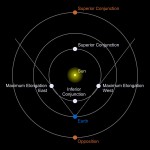As a planet moves across the sky there are particular points in its orbit that describe the motion, part of the jargon of astronomy that can confuse the uninitiated. These terms do not represent anything difficult, you just have to visualize what they mean. Understanding the movements of planets across the sky gives a little insight into our beautiful universe.

Superior Conjunction, Inferior Conjunction, Opposition and Maximum Elongation tell any experienced skywatcher exactly where a planet is with respect to the Earth, where it is in our sky, and where it will be in the coming weeks or months. It is all part of the intricate patterns of our solar system that allow anyone who learns to become familiar with the night sky.
Superior Conjunction
A conjunction is the close approach of any two objects in the sky. This does not mean that they are physically close in space, merely that they appear along the same line of sight. One object may be vastly further away, and indeed this is usually the case.
Superior and Inferior conjunction refer specifically to those times when a planet passes in front or behind the Sun as seen from our vantage point on the Earth. During these conjunctions the planet will be lost in the glare of the Sun and disappears from view for a time.
Superior conjunction is when a planet passes the other side of the Sun. Any solar system body in orbit around the Sun, comet, asteroid or dwarf planet will pass through superior conjunction.
Inferior Conjunction
Objects that orbit sunward of the Earth can pass through inferior conjunction. This is the point at which the object passes between the Earth and Sun. For the Major planets this includes Mercury and Venus, as well as any asteroids or other small bodies with an orbit that passes inside one astronomical unit.
These objects seldom pass directly in front of the Sun as seen from Earth, due to slight inclinations in the orbits the objects usually pass above or below our Sun as seen in the sky. When an object does pass directly in front of the Sun its silhouette can be seen against the disk using a solar telescope. Such an event is called a transit, and are often eagerly anticipated events for skywatchers.
Opposition
Objects that orbit outside the Earth’s orbit will pass through opposition, the moment the object is opposite the Sun in the Sky. This includes the major planets Mars, Jupiter, Saturn, Uranus and Neptune, as well as any small body outside the Earth’s orbit. Opposition can also be considered the moment when the Earth passes between the object and the Sun.
For a skywatcher keeping track, an outer planet completely crosses the night sky. After superior conjunction the object will appear in the morning sky, rising higher each day, eventually reaching opposition. After which the object can be observed further into the evening sky. In the weeks before superior conjunction the object will slowly slide into the glare of the Sun, disappearing into the sunset. Such objects do not experience maximum elongation or inferior conjunction. Thus two major events in the object’s orbit, at least for an earthbound observer, are opposition and superior conjunction.
During opposition the object will rise at sunset and transit near midnight, setting at dawn. Thus is well placed for observation through most of the night.
Maximum Elongation
Planets with interior orbits, Mercury and Venus, appear to rise out of the sun’s glare as its orbit takes the object further from the Sun as seen from our earthbound vantage point. Eventually the object reaches a furthest point before it again heads back into the glare, This furthest point from the Sun is referred to as maximum elongation.
Western elongation occurs in the morning sky when the planet is west of the Sun. Eastern elongation occurs in the evening sky.
Thus for inner planets the order of events is simple, superior conjunction is followed by maximum eastern elongation after the planet emerges from behind the Sun and is seen in the evening sky. The planet then moves through inferior conjunction, passing between the Sun and Earth to appear in the morning sky and head for maximum western elongation. After max elongation the planet then slides behind the Sun as seen from earth to superior conjunction.

